Can You Turn A Light Switch Into An Outlet? (Find Out Now!)

If you have a light switch that you hardly use, it might be more beneficial to convert it into an outlet. But can that even be done? The answer is a resounding yes!
With a few precautions, a light switch can be turned into an outlet. After you find the live wire, you need to remove the light switch and cap off any unnecessary wires. The wires that are left are connected to their proper terminals on the outlet.
Do You Need Electricial Wiring or Panel Upgrade Services?
Get free, zero-commitment quotes from pro contractors near you.

Steps to Turn a Light Switch into an Outlet
The process of turning a light switch into an outlet is easier than you might think.
- Find the live wire.
- Remove the black wires from the light switch. Cap off the black wire that’s attached to the fixture.
- Unscrew the green ground wires and locate the one that belongs to the black live wire.
- Cap off the white neutral wire that goes into the fixture.
- Connect the leftover white wire to the chrome terminal on the outlet.
- The leftover black wire connects to the brass terminal on the outlet.
- Connect the green ground wire to the ground screw. Be sure to screw it into the outlet box before attaching the plate.
How to Locate the Live Wire
Remove the cover plate from the light switch to expose the wires. You’ll find two black wires, two white wires, and two green wires. One of the black wires will be live.
Using a voltage tester, turn off the light switch and place one end of the tester on either of the black wires. Connect the other end to the green ground screw. If you get a reading above zero or if a green light turns on, you’ve located the live wire. If there’s no reading or light, test the other black wire.
Once you’ve established which black wire is live, turn off the circuit on the breaker panel that controls the light switch. Retest the wires to make sure none of them are giving off any voltage. If they are, you need to shut off more breakers until the reading is zero or there’s no green light.
Once you’re getting no readings from the wires, place a piece of tape on the black wire that was live. You’ll need to remember it for later.
Removing and Capping Wires
The black wires are attached to the light switch. Remove them and get rid of the switch. Now you’re left with the box and exposed wires.
The Black Wires
Cap off the black wire that isn’t marked with tape, and push it to the back of the box.
The Green Wires
Next, unscrew the green ground wires. Determine which one belongs to the live cable and push the other to the back of the box.
The White Wires
The white wires connect via a wire nut in the wall box. One should be going up the wall to the fixture. The other should be going down toward the junction box. Untwist the white wires at the wall box and cap off the one going toward the fixture. The one that’s left is needed for the outlet.
You are left with a green ground wire, a white wire, and an uncapped black wire that should all belong to the same cable.
Connecting the Wires to the Outlet
This part is a bit more self-explanatory as long as you can remember the corresponding colors: black goes to brass, white goes to chrome, green goes to ground.
Screw the black wire into the brass terminal. Then, screw the white wire into the chrome terminal. Finally, crew the green ground wire into the green ground screw.
A Note on Ground Screws
If you have an older home, you may find your ground cable went directly into the box inside the wall rather than on the outlet or light switch. Modern light switches and outlets have a ground screw right on them. This screw is where you would connect the green ground wire.
Related Questions
Do you still have questions about turning a light switch into an outlet? You’ve come to the right place! Here are some things other people asked about converting light switches to outlets.
Does it matter which set of terminals I attach the wires to?On an outlet, you’ll notice there are two brass terminals and two chrome terminals. It does not matter whether you connect the wires to the top or the bottom. However, whichever you choose for one should be the same for the other. If you connect the black wire to the top brass terminal, then you should connect the white wire to the top chrome terminal.
The only time the terminals matter is if you’re installing a GCFI outlet. In this case, you need to connect the wires to the terminal that says “LINE.”
How do you separate an outlet from a switch?If you have a switch that controls just an outlet (not a light fixture), you can easily remove the switch and keep power going to the outlet. Simply take the switch out and connect the two black wires to complete the circuit.
If the light switch also controls a fixture…you might want to call an electrician for help with that one. It involves rerouting and running new wires which are things best left to professionals.
What can I do with an unused light switch?If you don’t want to convert the unused switch to an outlet, eliminate it. Remove the wires that are connected to the switch and cap both ends. Cap both ends of the neutral wire and ground wire as well. Shove all of them into the wall box and repair the drywall.
Do You Need Electricial Wiring or Panel Upgrade Services?
Get free, zero-commitment quotes from pro contractors near you.

Summing It Up
If you have a light switch that goes unused, turning it into an outlet is a better use of electricity. It’s an easy process so long as you pay attention to the wire colors. Always make sure no voltage is coming from any wires during this process. If you’re unsure about anything, it’s always safest to contact a professional.

Brigid Levi is a wife, mother, and freelance writer who enjoys a good DIY project and creating beautiful spaces within her home. From cleaning and organization hacks to home decor ideas, she loves helping people in their quest to turn a house into a home. Her hobbies include pretending to be Joanna Gaines while updating her home with her husband and performing in local theater productions.
More by Brigid Levi














![10 Best Zero Turn Mowers – [2022 Reviews & Ultimate Buyer's Guide]](https://cdn-fastly.upgradedhome.com/media/2023/07/31/9070522/10-best-zero-turn-mowers-2022-reviews-ultimate-buyer-s-guide.jpg?size=350x220)




![How To Reset A Whirlpool Cabrio Washer [In 5 Easy Steps!]](https://cdn-fastly.upgradedhome.com/media/2023/07/31/9076531/how-to-reset-a-whirlpool-cabrio-washer-in-5-easy-steps.jpg?size=350x220)





![12 Washing Machine Brands to Avoid [with Recall Data]](https://cdn-fastly.upgradedhome.com/media/2023/07/31/9075781/12-washing-machine-brands-to-avoid-with-recall-data.jpg?size=350x220)

![10 Most Dangerous Neighborhoods in Baltimore [Updated]](https://cdn-fastly.upgradedhome.com/media/2023/07/31/9075655/10-most-dangerous-neighborhoods-in-baltimore-updated.jpg?size=350x220)